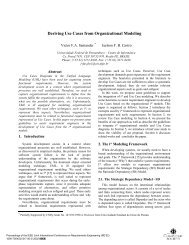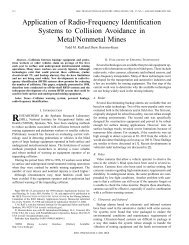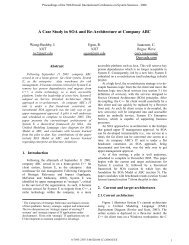an approach to security and privacy of rfid system for supply chain
an approach to security and privacy of rfid system for supply chain
an approach to security and privacy of rfid system for supply chain
Create successful ePaper yourself
Turn your PDF publications into a flip-book with our unique Google optimized e-Paper software.
ReaderID s<strong>to</strong>red in the memory <strong>of</strong> this tag has <strong>to</strong> be updated.<br />
In response, the database finds out the NewReaderID <strong>an</strong>d<br />
tr<strong>an</strong>smits it <strong>to</strong> the reader. When the reader receives the<br />
NewReaderID, it XOR it with the OldReaderID <strong>an</strong>d sends<br />
the XOR value <strong>to</strong> the tag. The tag c<strong>an</strong> obtain the<br />
NewReaderID from the XOR value <strong>an</strong>d the OldReaderID.<br />
Finally the ReaderID is updated.<br />
In this process, even if the XOR value between<br />
NewReaderID <strong>an</strong>d OldReaderID is leaked out, the adversary<br />
will not get the NewReaderID, because it has no knowledge<br />
<strong>of</strong> the OldReaderID. In this way, spo<strong>of</strong>ing is prevented.<br />
C. Analysis <strong>for</strong> typical cases<br />
1) Invulnerable <strong>to</strong> eavesdropping<br />
In the process <strong>of</strong> authentication, even if <strong>an</strong> adversary<br />
eavesdrops the reader’s output a(k), it c<strong>an</strong> not pretend <strong>to</strong> be<br />
<strong>an</strong> authorized reader in the following authentication rounds.<br />
The reason is that the required a(k) value ch<strong>an</strong>ges <strong>for</strong> every<br />
authentication processes. The a(k) value <strong>of</strong> the <strong>for</strong>mer<br />
authentication round is useless <strong>for</strong> the later authentication.<br />
After authentication, the tag will output the hash value <strong>of</strong> its<br />
TagID instead <strong>of</strong> the TagID itself. Since hash function is<br />
hardly <strong>to</strong> inverse, the TagID is protected even if the output<br />
is captured by <strong>an</strong> adversary.<br />
When a tag w<strong>an</strong>ts <strong>to</strong> update a new ReaderID in its memory,<br />
the new ReaderID is encrypted with the old ReaderID. It is<br />
invulnerable <strong>to</strong> eavesdropping.<br />
In one word, the proposed <strong>approach</strong> is secure when <strong>an</strong>y<br />
communications between readers <strong>an</strong>d tags are eavesdropped.<br />
2) Prevent being tracked by adversary<br />
Tags keep silent <strong>to</strong> adversaries. They only respond <strong>to</strong><br />
authenticated readers. Furthermore, as explained above, it is<br />
impossible <strong>for</strong> adversaries <strong>to</strong> pretend <strong>to</strong> be a “good reader” .<br />
Since there is no tag output, adversaries are unable <strong>to</strong> track<br />
the cus<strong>to</strong>mers by the tags tagged <strong>to</strong> what they just bought<br />
after they check out. The <strong>privacy</strong> <strong>of</strong> location <strong>an</strong>d the objects<br />
the cus<strong>to</strong>mers carry is protected.<br />
3) Low computation load<br />
This scheme is fast <strong>an</strong>d low-cost. When identifying a tag<br />
from N known tags, the reader per<strong>for</strong>ms only one hash<br />
operation <strong>an</strong>d a search <strong>of</strong> N known IDs, while other<br />
<strong>approach</strong>es <strong>of</strong> r<strong>an</strong>domized access control (section II. C.)<br />
need at least N hash operations <strong>an</strong>d N searches . Obviously,<br />
the computation load <strong>of</strong> this proposed scheme is<br />
dramatically low, compared with the schemes at the similar<br />
<strong>security</strong> level. Moreover, as the authentication process<br />
relies on searching N known IDs <strong>an</strong>d a hash, the<br />
computation load increases gradually as the number <strong>of</strong> tags<br />
increases.<br />
4) Suitable <strong>for</strong> a large number <strong>of</strong> tags<br />
Since the computation load is low <strong>an</strong>d increase slowly with<br />
the number <strong>of</strong> tags, the proposed <strong>approach</strong> is suitable <strong>for</strong><br />
protecting RFID <strong>system</strong>s with a large number <strong>of</strong> tags. This<br />
feature is very import<strong>an</strong>t <strong>for</strong> a <strong>supply</strong> <strong>chain</strong>. Each part along<br />
a <strong>supply</strong> <strong>chain</strong> deploys <strong>of</strong> numerous tags. In warehouses or<br />
retail s<strong>to</strong>res, thous<strong>an</strong>ds <strong>of</strong> products need <strong>to</strong> be tagged <strong>to</strong><br />
accelerate <strong>supply</strong> <strong>chain</strong> process. There<strong>for</strong>e, a secure RFID<br />
scheme suitable <strong>for</strong> a lot <strong>of</strong> tags is the prerequisite <strong>for</strong> the<br />
popularization <strong>of</strong> RFID <strong>supply</strong> <strong>chain</strong> <strong>system</strong>.<br />
5) Scalable <strong>for</strong> further services <strong>for</strong> consumers<br />
The <strong>approach</strong> proposed in this paper is scalable <strong>for</strong> further<br />
services <strong>for</strong> consumers. For example, a consumer c<strong>an</strong> s<strong>to</strong>re<br />
the ReaderID <strong>of</strong> his home in the tag’s memory, which is<br />
tagged <strong>to</strong> a box <strong>of</strong> milk he bought from a supermarket. The<br />
reader in the refrigera<strong>to</strong>r will detect milk <strong>an</strong>d let the owner<br />
know whether there is enough milk.<br />
IV. CONCLUSION<br />
This paper proposed <strong>an</strong> <strong>approach</strong> <strong>to</strong> <strong>security</strong> <strong>an</strong>d <strong>privacy</strong><br />
protection in RFID <strong>system</strong>s, especially <strong>for</strong> <strong>supply</strong> <strong>chain</strong>. It<br />
requires the tag <strong>to</strong> have a rewritable memory <strong>an</strong>d a simple<br />
logic circuit. These requirements are practical <strong>an</strong>d easy <strong>to</strong><br />
implement.<br />
An adv<strong>an</strong>tage <strong>of</strong> the proposed <strong>approach</strong> is the high <strong>security</strong>.<br />
It prevents spo<strong>of</strong>ing, m<strong>an</strong>-in-the-middle attack. Adversary<br />
c<strong>an</strong> not get the tag ID even if the tag’s outputs are<br />
eavesdropped.<br />
REFERENCES<br />
[1] Vince St<strong>an</strong><strong>for</strong>d, “ Pervasive computing goes the last<br />
hundred feet with RFID <strong>system</strong>s”, IEEE pervasive<br />
computing, Volume: 2 , Issue: 2 , Pages:9 – 14,April-<br />
June 2003<br />
[2] Au<strong>to</strong>-ID Center, “860MHz-960MHz Class I Radio<br />
Frequency Identification Tag Radio Frequency &<br />
Logical communication Interface Specification Proposed<br />
Recommendation Version 1.0.0” , Technical Report<br />
MIT-AUTOID-TR-007, Nov. 2002<br />
[3] Sozo Inoue, Hiro<strong>to</strong> Yasuura, “ RFID <strong>privacy</strong> using usercontrollable<br />
uniqueness” , RFID Privacy Workshop @<br />
MIT,2003<br />
[4] Sozo Inoue, S. Konomi, Hiro<strong>to</strong> Yasuura., “Privacy in the<br />
digitally named world with RFID tags” , Workshop on<br />
socially-in<strong>for</strong>med design <strong>of</strong> <strong>privacy</strong>-enh<strong>an</strong>cing solutions<br />
in ubiqui<strong>to</strong>us computing, 2002<br />
[5] Shingo Kinosita, Fumitaka Hoshino, Tomoyuki Komuro,<br />
Akiko Fujimura <strong>an</strong>d Miyako Ohkubo, “ Non-identifiable<br />
Anonymous-ID Scheme <strong>for</strong> RFID Privacy Protection” ,<br />
<strong>to</strong> appear in CSS 2003 in Jap<strong>an</strong>ese.<br />
[6] Stephen A. Weis, S<strong>an</strong>jay E. Sarma, Ronald L. Rivest <strong>an</strong>d<br />
D<strong>an</strong>iel W. Engels , “Security <strong>an</strong>d Privacy Aspects <strong>of</strong><br />
Proceedings <strong>of</strong> the IEEE International Conference on E-Commerce Technology <strong>for</strong> Dynamic E-Business (CEC-East’04)<br />
0-7695-2206-8/04 $ 20.00 IEEE






